

How the axe gave humans their hands: Researchers find weapons key to evolution. Newly discovered bone helps to explain the evolution of human handsThe 1.4 million-year-old bone - a third metacarpal - shows how hands changed between 1.7 million years ago and 800,000 years agoIt runs across the palm joining the wrist and middle finger and keeps the wrist steady while a small object is held between the thumb and fingersPeople with this bone had an evolutionary advantage as they could use stone hand axes more effectively By Emma Innes Published: 14:09 GMT, 12 April 2013 | Updated: 16:06 GMT, 12 April 2013 A newly discovered fossil is helping to explain how human hands evolved into their current form.
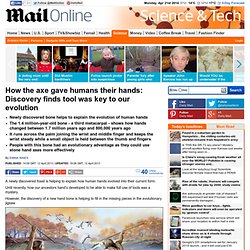
Until recently, how our ancestors hand’s developed to be able to make full use of tools was a mystery. However, the discovery of a new hand bone is helping to fill in the missing pieces in the evolutionary jigsaw. A newly discovered fossil is helping to explain how human hands evolved to allow the efficient use of tools and weapons. Biggest ever study of Australopithecus sediba.
The family tree test that rewrote human history: Researchers stunned to find DNA submitted to online service dates back 338,000 years. Discovery made after American submitted his DNA to a family tree service DNA traced to Mbo, a population living in a tiny area of western CameroonProves last common Y chromosome ancestor lived 338,000 years ago, even though oldest fossil of modern man is only 200,000 years old By Mark Prigg Published: 09:02 GMT, 7 March 2013 | Updated: 10:31 GMT, 7 March 2013 A DNA test on an American hoping to trace his family tree has come up with a stunning result - the roots of the human tree date back much further than previously thought.
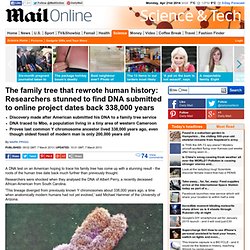
Researchers were shocked when they analysed the DNA of Albert Perry, a recently deceased African-American from South Carolina. 'Missing link' human ancestor ate leaves and fruit from the trees, like chimps. Two-million-year-old South African had different diet to other pre-humans'Missing link' fossil analysed to judge dietShort, gangly creature ate leaves and fruit like chimps By Rob Waugh Published: 18:01 GMT, 27 June 2012 | Updated: 18:01 GMT, 27 June 2012 Two million years ago, one of our distant ancestors lived on leaves and fruit from the trees in Africa.

Scans of fossil teeth show the short and gangly South African Australopithecus sediba lived on a hard diet of trees, bushes and fruit two million years ago - similar to a chimpanzee. But virtually all other ancient human ancestors from Africa tucked into softer meals of grasses and sedges - even the 'Nutcracker Man', Paranthropus boisei, with his massive jaws and teeth. An analysis of the teeth of the short, gangly hominin australopithecus sediba shows it had a diet unlike virtually all of our other known ancestors. We weren't alone! Scientists confirm there were two other species of early human beings. Research that could set humanity back 20,000 years: Ornaments and tools show that Modern Man emerged 44,000 years ago (much earlier than we thought) By Eddie Wrenn Published: 21:50 GMT, 30 July 2012 | Updated: 21:50 GMT, 30 July 2012 Human behaviour, as we know it, emerged 44,000 years ago - much earlier than previously thought, according to a new study.
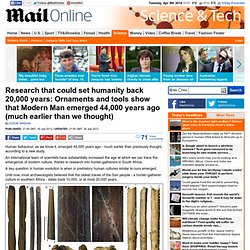
An international team of scientists have substantially increased the age at which we can trace the emergence of modern culture, thanks to research into hunter-gatherers in South Africa. A key question in human evolution is when in prehistory human cultures similar to ours emerged. Until now, most archaeologists believed that the oldest traces of the San people - a hunter-gatherer culture in southern Africa - dates back 10,000, or at most 20,000 years. Some of the evidence from the Border Cave area (see panel below) shows that humans used tools and ornaments 44,000 years ago a) Wooden digging stick made from Flueggea virosa and dated 40,986 - 38,986 cal BP c) Bone arrow point decorated with a spiral incision filled with red pigment b) Close up showing rounding and crushing of the tip. Earliest 'completely modern' skull which dates back 50 millennia suggests we left Africa 20,000 years earlier than expected. Skull found in cave in Annamite mountains, Laos, dates from 46,000 and 63,000 years agoPrevious discoveries suggested humanity only left Africa around 27,000 years ago.
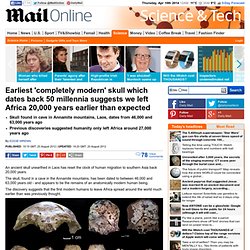
Humans began eating plants 180,000 years ago 'to aid brain development' ... and this could still be affecting your diet today. Adapting to a part-vegetarian diet helped early humans lose their dependence on fishGenetic study suggests plant fats accelerated development of the brain, and allowed mass-emigration from AfricaFindings 'may explain why diverse racial and ethnic populations respond differently to the modern Western diet' By Eddie Wrenn Published: 08:36 GMT, 21 September 2012 | Updated: 08:36 GMT, 21 September 2012 Early man: Without an adaptation which allowed us to process vegetables, modern man's brain may have remained under-developed Modern humans were able to emerge from Africa after a genetic mutation allowed them to become vegetarian, a new study claims.

The change meant humans were able to move away from water sources and spread across the continent. Geneticists have compared DNA sequences from numerous people around the world to determine how different populations relate to one another and when they might have gone their separate ways. New analysis of how humans expanded out of Africa could explain rise of wheat and milk allergies. New study draws together anthropological and genetic records for most-complete account yetShows how genes responsible for gluten and lactose intolerance emerged as Europeans embraced agriculture 10,000 years agoResearchers also hope their work can inform medical treatment of groups susceptible to genetic diseases By Damien Gayle.

Man came down from the trees much later than thought: New analysis of 3.3m-year-old girl shows shoulders adapted for climbing. Fossilised shoulder blades of three-year-old Australopithecus afarensis from Ethiopia show her kind were still adapted for tree climbingShe is of the same species as Lucy, the famous 3.2million year old skeleton discovered in partial form in 1974 By Damien Gayle Published: 11:02 GMT, 26 October 2012 | Updated: 16:07 GMT, 26 October 2012 One ancient little girl: The skull of Selam, whose remains have now revealed that human ancestors remained tree-climbers for longer than thought Analysis of the bones of a girl who died 3.3million years ago in East Africa suggests our ancestors came down from the trees later than many scientists thought.
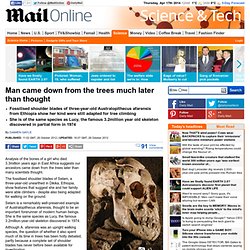
The fossilised shoulder blades of Selam, a three-year-old unearthed in Dikika, Ethiopia, show features that suggest she and her family were able climbers - despite also being adapted for walking on the ground. Fossil pre-human foot from Ethiopia helps scientists home in on the moment our ancestors descended from the trees. Foot built for walking on two feet - but also for grasping branchesPreviously unknown ancestor lived three million years ago By Rob Waugh.

Pointing to the past: Scientists sequence whole genome of 'Denisovan' caveman from fossilised finger bone in Siberian cave. Stone Age cavemen, 'an entirely new species', discovered in China. 'Red deer people' lived 14,500-11,500 years ago in AsiaPreviously thought that homo sapiens had continent to themselves'Highly unusual' mixture of ancient and modern - could be new speciesCould also be relic of early migration out of Africa which died out By Rob Waugh Published: 15:00 GMT, 14 March 2012 | Updated: 09:27 GMT, 16 March 2012 Four Stone Age people found in caves in China could be a entirely new species of humanoid - and the discovery 'opens a new chapter' in the history of evolution, say archaeologists.

The fossils, found in two caves, belong to a previously unknown Stone Age people and have a 'highly unusual' mixture of ancient and modern features. Named the 'Red Deer people' because of the animals they hunted and dating from between 14,500 to 11,500 years ago, they are the youngest humanoid fossils to be found in Asia. Previously it had been thought that early humans had little competition in the continent. But the new find suggests this may not have been the case. 'The oldest work of art ever': 42,000-year-old paintings of seals found in Spanish cave. Six paintings were found in the Nerja Caves, 35miles east of MalagaThey are the only known artistic images created by Neanderthal man By Tom Worden for MailOnline Updated: 21:27 GMT, 7 February 2012 The world's oldest works of art have been found in a cave on Spain's Costa del Sol, scientists believe.
Six paintings of seals are at least 42,000 years old and are the only known artistic images created by Neanderthal man, experts claim. Professor Jose Luis Sanchidrian, from the University of Cordoba, described the discovery as 'an academic bombshell', as all previous art work has been attributed to Homo sapiens. Humans may not be descended from Neanderthals after all say scientists as they find DNA similarities are not the result of interbreeding. By Mark Prigg Published: 07:24 GMT, 14 August 2012 | Updated: 08:21 GMT, 14 August 2012 We may not, as previously thought, have a little bit of Neanderthal in us, scientists have revealed. Similarities between the DNA of modern people and Neanderthals are more likely to have arisen from shared ancestry than interbreeding, a new study has found. The team from the University of Cambridge published their new theory this week in PNAS journal.
Similarities between the DNA of modern people and Neanderthals are more likely to have arisen from shared ancestry than interbreeding, a study has found Previously, it had been suggested that interbreeding was common, explaining our shared genome. However, the newly published research proposes a different explanation. Cambridge evolutionary biologists Dr Anders Eriksson and Dr Andrea Manica, found that the amount of DNA shared between modern Eurasian humans and Neanderthals - estimated at between 1-4% - actually comes from a common ancestor. Are you a farmer or a hunter? The two types of early European revealed. Farming key to the development of EuropeTwo distinct groups of early Europeans existed: Farmers and hunter gatherers. Neanderthals were actually home-bodies who spent most of their time doing chores. Neanderthals big right arms were actually from doing choresOur ancestors spent much of their time skinning prey'Domestic' hominids spent time at home preparing animals.
Swimming apes and the reason we all feel healthier by the sea. Humans share genetic code with endangered ape species the bonobo. Humans are a 'mosaic' of bonobo and chimpanzee genomesBonobos live only in the war-torn Democratic Republic of CongoDon't fight but mate repeatedly (and ruled by alpha females)Chimps and bonobos were only discovered to be different species 90 years ago By Daily Mail Reporter. Acanthodes bronni: Humans evolved from a prehistoric SHARK from 300m years ago.